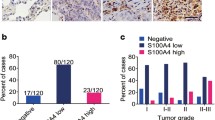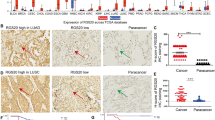Abstract
Purpose
There is not much progress in the treatment for lung squamous cell carcinoma LSCC in the past few years. Rapamycin Rapa, an inhibitor of mammalian target of rapamycin mTOR, has exhibited antitumor efficacy in a variety of malignant tumors. It has recently been reported that Rapamycin can induce autophagy signaling pathway in lung cancer and Glypican-3GPC3 can promote the growth of hepatocellular carcinoma by stimulating canonical Wnt signaling pathway. The aim of this study is to investigate the mechanisms of rapamycin’s antitumor efficacy in relation to GPC3/Wnt/β-catenin pathway and autophagy in LSCC.
Methods
SK-MES-1 cells, a LSCC cell line, were treated with various concentrations of rapamycin with or without Glypican-3 GPC3-targeting siRNA. SK-MES-1 cell proliferation was determined by MTT assay. Protein expression levels of GPC3, β-catenin, Beclin-1 were checked via western blotting. We established the xenograft mice model to investigate the suppression effect of rapamycin on LSCC. In addition, we further testified the metabolism protein of autophagy process using the xenograft tumor tissue.
Results
Rapamycin could inhibit the SK-MES-1 cell proliferation in a concentration-dependent manner both in vitro and in vivo by decreasing the GPC3 expression and downregulating the glypican-3/Wnt/β-catenin signaling pathway. In addition, we found that GPC3 silencing can activate the glypican-3/Wnt/β-catenin pathway and autophagy, which contribute to the suppression of tumor growth both in vitro and in vivo.
Conclusion
Rapamycin suppresses the growth of lung cancer through down-regulating glypican-3/Wnt/β-catenin signaling, which mediates with activation of autophagy. This study suggests GPC3 is a new promising target for rapamycin in the treatment of lung cancer.




Similar content being viewed by others
References
Arriola Apelo SI, Lamming DW (2016) Rapamycin: an InhibiTOR of aging emerges from the soil of Easter Island Journals of Gerontology Series A: Biomedical Sciences and Medical. Sciences 71:841–849
Atlanta G (2015) Cancer facts and figures. American Cancer Society, Atlanta, pp 58–72
Baldini E, Tibaldi C, Paoli CD (2020) Chemo-radiotherapy integration in unresectable locally advanced non-small-cell lung cancer: a review. Clin Trans Oncol 3:1–6
Balsara BR et al (2004) Frequent activation of AKT in non-small cell lung carcinomas and preneoplastic bronchial lesions. Carcinogenesis 25:2053–2059
Bao L, Chandra PK, Moroz K, Zhang X, Thung SN, Wu T, Dash S (2014) Impaired autophagy response in human hepatocellular carcinoma. Exp Mol Pathol 96:149–154
Baumhoer DTL, Stadlmann S et al (2008) Glypican 3 expression in human nonneoplastic, preneoplastic, and neoplastic tissues: a tissue microarray analysis of 4387 tissue samples. Am J Clin Pathol 1:899–906
Capurro M, Xiang YY, Lobe C, Filmus J (2005) Glypican-3 promotes the growth of hepatocellular carcinoma by stimulating canonical Wnt signaling. Cancer Res. https://doi.org/10.1158/0008-5472.can-04-4244
Cecconi F, Levine B (2008) The role of autophagy in mammalian development: cell makeover rather than cell death. Dev Cell 15:344–357
Chen H-Y, White E (2011) Role of autophagy in cancer prevention Cancer prevention research. Mole Med Rep 4:973–983
Cheng A-L et al (2008) Efficacy and safety of sorafenib in patients in the Asia-Pacific region with advanced hepatocellular carcinoma: a phase III randomised, double-blind, placebo-controlled trial. Lancet Oncol 10:25–34
Detterbeck FC, Boffa DJ, Kim AW, Tanoue LT (2017) The eighth edition lung cancer stage classification. Chest 151:193–203
Edelman MJ (2017) Highlights in the treatment of lung cancer: what’s new? Not Much. JAMA Oncol 3:301–302
Euvrard S, Ulrich C, Lefrancois N (2004) Immunosuppressants and skin cancer in transplant patients: focus on rapamycin. Dermatol Surg 30:628–633
Gao H et al (2014) Development of T cells redirected to glypican-3 for the treatment of hepatocellular carcinoma Clinical cancer research: an official journal of the American Association for Cancer Research. Gastroenterology 20:6418–6428
Glick D, Barth S, Macleod KF (2010) Autophagy: cellular and molecular mechanisms. J Pathol 221:3–12
Kim HS, Mitsudomi T, Soo RA, Cho BC (2013) Personalized therapy on the horizon for squamous cell carcinoma of the lung. Lung Cancer 80:249–255. https://doi.org/10.1016/j.lungcan.2013.02.015
Kimura N et al (2003) A possible linkage between AMP-activated protein kinase AMPK and mammalian target of rapamycin mTOR signalling pathway. Genes Cells 8:65–79
Masui K, Harachi M, Cavenee WK, Mischel PS, Shibata N (2020) mTOR complex 2 is an integrator of cancer metabolism and epigenetics. Cancer Lett 478:1–7. https://doi.org/10.1016/j.canlet.2020.03.001
Midthun D (2014) Overview of the initial evaluation, treatment and prognosis of lung cancer. UpToDate Inc
Mita MM, Mita A, Rowinsky EK (2003) The molecular target of rapamycin mTOR as a therapeutic target against cancer. Cancer Biol Ther 2:168–176
Pilia G et al (1996) Mutations in GPC3, a glypican gene, cause the Simpson-Golabi-Behmel overgrowth syndrome. Nat Genet 12:241
Postmus P et al (2017) Early and locally advanced non-small-cell lung cancer NSCLC: ESMO clinical practice guidelines for diagnosis, treatment and follow-up. Ann Oncol 28:1–21
Reddy D, Kumavath R (2019) Lanatoside C Induces G2/M Cell Cycle Arrest and Suppresses Cancer Cell Growth by Attenuating MAPK, Wnt, JAK-STAT, and PI3K/AKT/mTOR Signaling Pathways. Biomolecules. https://doi.org/10.3390/biom9120792
Reddy D, Ghosh P, Kumavath R (2019) Strophanthidin attenuates MAPK, PI3K/AKT/mTOR, and Wnt/β-Catenin signaling pathways in human cancers. Front Oncol 9:1469
Reddy D, Kumavath R, Tz T, Ampasala DR, Kumar AP (2020) Peruvoside targets apoptosis and autophagy through MAPK Wnt/β-catenin and PI3K/AKT/mTOR signaling pathways in human cancers life. sciences 241:117–147
Reya T, Clevers H (2005) Wnt signalling in stem cells and cancer. Nature 1:434–843
Ruan J et al (2011) Inhibition of glypican-3 expression via RNA interference influences the growth and invasive ability of the MHCC97-H human hepatocellular carcinoma cell line. Internat J Mole Med 28:497–503
Sehgal S, Baker H, Vézina C (1975) Rapamycin AY-22, 989, a new antifungal antibiotic. J Antibiot 28:727–732
Si AA, Dw L (2016) Rapamycin: an InhibiTOR of aging emerges from the soil of Easter Island journals of gerontology series A: Biomedical Sciences and Medical. Sciences 71:841–849
Siegel RL, Miller KD, Jemal A (2015) Cancer statistics, 2015 CA: a cancer journal for clinicians. Oncotarget 65:5–29
Skeen JE et al (2006) Akt deficiency impairs normal cell proliferation and suppresses oncogenesis in a p53-independent and mTORC1-dependent manner. Cancer Cell 10:269–280
Vicary GW, Roman J (2016) Targeting the mammalian target of rapamycin in lung cancer. Am J Med Sci 352:507–516
Yamauchi N et al (2005) The glypican 3 oncofetal protein is a promising diagnostic marker for hepatocellular carcinoma Modern pathology : an official journal of the United States and Canadian academy of pathology. Modern Pathol 18:1591–1598. https://doi.org/10.1038/modpathol.3800436
Yuan R, Kay A, Berg WJ, Lebwohl D (2009) Targeting tumorigenesis: development and use of mTOR inhibitors in cancer therapy. J Hematol Oncol 2:45
Funding
This work was supported by National Natural Science Foundation of China 81602703, the Natural Science Foundation of Ningbo2018A610382, Zhejiang Medicine and Health Sciences Research Fund 2020379758, 2019 Jiaxing Key Discipline of Medicine—OncologySupporting Subject2019-zc-11.
Author information
Authors and Affiliations
Corresponding author
Ethics declarations
Conflict of interest
None.
Additional information
Publisher's Note
Springer Nature remains neutral with regard to jurisdictional claims in published maps and institutional affiliations.
Rights and permissions
About this article
Cite this article
Bi, Y., Jiang, Y., Li, X. et al. Rapamycin inhibits lung squamous cell carcinoma growth by downregulating glypican-3/Wnt/β-catenin signaling and autophagy. J Cancer Res Clin Oncol 147, 499–505 (2021). https://doi.org/10.1007/s00432-020-03422-4
Received:
Accepted:
Published:
Issue Date:
DOI: https://doi.org/10.1007/s00432-020-03422-4




